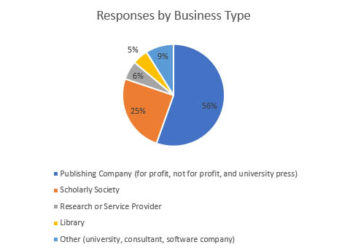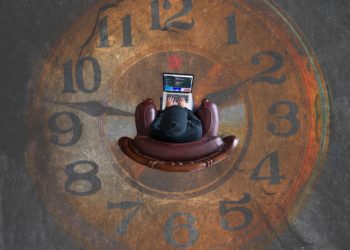At a time when organizations are freezing open positions or even downsizing staff, it seems a novelty that people are starting new jobs… by choice! Some people seem rather impressed when you tell them you have landed a new opportunity during a pandemic. Others inevitably ask, “It is weird to start a new job with everyone remote?”
Despite the not-so-normal circumstances, opportunities present themselves when they feel like it. Whether we are open to those opportunities at any given time depends on a lot of variables. During a global crisis, when the news seems bad and overwhelming, it’s easy to close ourselves to opportunities. On the other hand, being stuck at home during a time of serious uncertainty can afford us the opportunity to reflect on our personal goals.

We (Jennifer and Angela) both saw an opportunity present itself and despite (or because of) the weird times, decided to fling open that door and charge through it. Jennifer moved from the American Society of Plant Biologists (ASPB) to the American Urological Association (AUA). Angela moved from the American Society of Civil Engineers (ASCE) to the American Society of Clinical Oncology (ASCO).
We were commiserating on Twitter about the strangeness as we have both found ourselves in this position over the last few months. Today we will share our thoughts on the experience and tips on what has made these transitions successful.
The Interview
The interview process was incredibly professional at both organizations despite the circumstances. Participating in a series of virtual online interviews can be disconcerting. That said, the first step is acknowledging the weirdness. The conversations were meaningful, the interviewers were thoughtful and well-informed.
There are definitely ways in which all parties involved can make this virtual process work.
The Interviewer/HR Recruiter
- As much advanced information as possible is helpful — how the process will go, who the candidate will be meeting with, etc.
- Provide links and let the interviewee know what kind of technology you will be using. We all have plugins now for just about every video conference platform, but it’s helpful to know which will be used ahead of time.
- Be clear about how much time the interviews are scheduled for. Many of us now have kids at home or are sharing workspace with partners, roommates, or curious pets. If we need to send the kids on a long walk with the dog during the interview, it’s good to know how long it will be.
The Interviewee
- Practice your introduction and your presentation of standard interview questions. Seeing yourself on video is different than an in person meeting so practice in a mirror or just with your webcam.
- Make sure the software works well on the device you will use for the interview and that the microphone and video both work. Turn off other apps or software on the device you are using so you’re not distracted by notifications.
- Set up your space. Think about what will be in camera view and whether you are comfortable with that. Make sure you have a drink of water and a quiet space.
- Don’t forget to take notes and ask lots of questions. You will want to know how the organization is handling pandemic working arrangements, for instance.
- Dress appropriately, but also in a way that makes you feel confident. You may feel okay on a regular work day in yoga pants and a professional top, but an interview requires that you feel your best going in.
In normal circumstances, making it through the entire process and then receiving a job offer can be overwhelming. You are excited for an amazing new chance to start the next step of your career, but reluctant to leave your team behind. This uncertainty can be much more complicated when you are already worried or unsure about the future.
Leaving a Job
For both of us, leaving was a whole lot harder than starting a new job in a pandemic.
It is hard enough leaving a job you have loved and people you like being with, but it is that much harder when you can’t tell them you are leaving in person.
Delivering the news over and over on video meetings is as awful as it sounds. At a certain point, you realize that you are going to have to go to an empty office building to retrieve your items alone and that you won’t be back in that community space with people again.
Both organizations were kind enough to organize farewell parties for us over video conference. One by one, colleagues showed up in their little squares, sharing favorite stories of their time with us. Jennifer’s colleagues at ASPB showed up wearing hot pink, her signature color. ASCE sent Angela not one, but two delicious fruit arrangements as well as personal notes and tokens of appreciation.
The rest of the exit process is as you would expect. It was helpful to have a video call to walk through all the things you may not know about leaving a job — your insurance, how to get a W-2 later on, what happens to your retirement account, etc. It’s a lot to only have in writing and being able to ask questions in the moment was helpful.
Official Onboarding
Virtual onboarding requires expert execution by Human Resources and IT departments, as well as supervisors, team members, and colleagues.
Knowing that day one will require access to computers and systems, a technology transfer needs to take place before the first day. Whether it’s a dedicated pick up time at the physical office or home delivery of computers, phones, etc., it was appreciated to have a few days to get space set up and know at least how to log on.
ASCO had a very comprehensive technology onboarding process with detailed instructions on how to set up and access systems. This spanned two days and also includes a Microsoft Teams channel specifically for new employees with ready access to help.
The AUA arranged for Jennifer to pick up her equipment at a safe social distance at the empty office. They set her up with email, access to the network, and a GoToMeeting account so everything was running smoothly the day she started.
It can be overwhelming to start a new job with loads of new people to meet and lots of “getting up to speed.” In the virtual space, this translates into lots and lots of video meetings. Video meetings are exhausting already. In a new job, you are trying to build rapport, get a sense for the management style of your boss, figure out the “tone” of the organization. This can be much harder to do on video calls. Try to make time for “social” conversations. And don’t forget, people are eager to meet you and will appreciate that you reach out to them to initiate good working relationships.
Trying to replicate virtually what used to happen in person for new hires can lead to extreme Zoom fatigue. Onboarding may need to include more short videos of tasks, some independent reading, or one-on-one phone calls with peers doing similar jobs.
In both our organizations, team members and peers have gone out of their way to acknowledge the “weirdness” and be accessible for questions. If you have a less formal mode of communication, like chat features, having people pop in now and then to ask how your day is going or if you have questions is very much appreciated. Most importantly, though, they have made us feel welcome and wanted.
Choosing to Make a Change
Neither one of us was looking for a new job. Jennifer received the description for the AUA role in her inbox and might have just deleted it any other time. Instead, she reviewed the email to find a position description perfectly tailored to her strengths. Away from the safe cocoon of ASPB, she had the courage to step outside of a comfortable situation and take a leap.
Angela was approached by a recruiter who helped facilitate the process. Opportunities to advance do not present themselves everyday. An argument can be made to remain steady in the face of overwhelming uncertainty. A counter argument can be made to do something scary when certainty is scarce.
We are both very fortunate to have a choice on whether to change jobs. And it can certainly be weird to make a transition when everyone is working from home. That said, with a little extra planning and effort, it can be a successful and welcoming experience.
If you have started a new job or onboarded a new employee recently, we would love to hear your feedback and tips on how to manage this successfully.
A special thank you goes to John Long and Karen Stanwood for providing their personal experiences for this post.

Discussion
9 Thoughts on "Changing Jobs During a Pandemic"
Congratulations to you both! Thank you for sharing your experiences.
Like you both, I started a new job in the higher education space during the thick of COVID-19. I was nervous but with an open mind, I decided to make the leap. I went from a hybrid office environment at Taylor & Francis Group to a fully remote environment at Ex Libris. My work equipment arrived by mail and my team welcomed me with virtual happy hours and on-boarding activities. What gave me the confidence to make a move was how strategic of a sales organization I was walking into with a true mission to help customers in the higher education space. I cannot say enough about the company culture at Ex Libris during the pandemic as although not meeting most of my colleagues face-face, I feel very connected to others across the organization. The former role I was in was a combination of customer retention, new business, and managing a small sales staff. I am now in a pure sales role licensing SaaS solutions in the higher ed. space. I had no idea how I would be able to ‘connect’ with new customers to develop relationships but ‘Teams with video’ became my best friend . If you’re fortunate enough to have a great opportunity present itself during these unusual times, consider taking a chance – I am really glad I did.
Thank you for sharing, Elyse and congratulations on the new job. Sales must be particularly challenging with no travel and no face-to-face. My 13 year old daughter and I were just having the conversation last night about how virtual doesn’t always mean you can’t do what you did before, it just means that you have to do it differently.
I’m wondering about negotiating for flexible hours or other accommodations given the restrictions on many caregivers now — are prospective employers open to hiring parents of young children, for example?
Great question. I am very open in the interview process about having kids, how old they are, etc. These are not questions that potential employers are allowed to ask. So you have to feel comfortable “outing” yourself as having caregiver needs. ASCO has a pretty flexible work policy anyway, so I felt confident that any flexibility I needed would be fine. Had I been considering a company that wasn’t already flexible, I would likely have had to ask more about when the offices were opening and what considerations would be given for parents of kids.
But to your main question, they cannot ask you if you have kids. It is illegal in the US to not hire someone based on marital status or whether they have kids (or are planning to have kids).
I can relate to this one! I started a new position in higher ed in May. While I’d frequently worked (and reported to) colleagues in other offices in the past, this is a whole different ballgame. Everyone has been very nice and supportive, but it’s tricky to enter a scenario where everyone has already met and worked together in person, while you are meeting most folks for the first time in small boxes. The other day I said I hadn’t met someone before when I actually had (over Zoom of course). I was completely embarrassed, but I feel fairly certain that wouldn’t have happened in an in-person setting. While I fully appreciate the conveniences of working remotely, there’s a lot to be said for the casual, unplanned interactions that take place in the kitchens, hallways, and elevators of offices. Those interactions help build relationships. The lack of those can be a bit isolating and overcoming that lack by attending all the Zoom happy hours (after a long day of business Zoom-ing) can feel a little forced and uncomfortable, not to mention tiring!
I think relationship building is the key part. I had a video meeting with everyone on my team yesterday and did a little powerpoint presentation about myself. I included personal details and gave them a chance to ask questions. So I learned that several others on the team grew up in Connecticut and that there was another Girl Scout leader in the group. I think we just need to look for opportunities to share when we are in video calls in order to make those connections. I also find it helpful that when on video calls, everyone’s names appear with their picture. I am bad at names.
Thanks for sharing your experiences. This was both timely and useful! I too switched jobs recently, and it was quite an interesting journey. I left a dyed in the wool stem publisher to join a library vendor, which is just launching a suite of services in the academic market. My first week consisted of 22 video training meetings! I do agree that virtual meetings can be very tiring, but they can also be quite useful in building rapport with coworkers you have not yet met. Virtual on-boarding was pleasantly effective. Surprisingly, I truly enjoyed it! I’m lucky to be joining a small but mighty team of people who share a similar “entrepreneurial” vision. I would love to create virtual happy hours and host team-building events – Thank you for all these great ideas. And good luck to you both!
I consider myself lucky that I have been working from home full time since well before the pandemic came along, so although boarding mostly remotely was difficult, it helps you to appreciate the full utility of these new applications. Imagine if this pandemic had happened even just 10 years ago! We would pretty much not even have the option of changing jobs, let alone effectively on boarding.
Congrats on your new roles, ladies! Angela, I had almost forgotten you’re a fellow Nutmegger like me. I’m sure ASCE will miss you! It was a great place to work.



